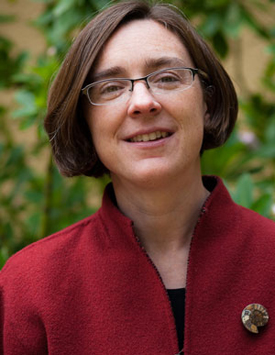Biology professor earns NSF CAREER grant
June 24, 2010 -- Kimberly D. Tanner, associate professor of biology, was awarded this month a $621,997 CAREER grant from the National Science Foundation, its most prestigious award in support of faculty early in their career. As director of the Science Education Partnership and Assessment Laboratory (SEPAL), Tanner will use her grant to investigate how university biology students learn to think like biologists. In a Q&A in the spring issue of the SF State Magazine, Tanner discussed what’s behind her efforts to improve how science is taught.

Associate Professor of Biology Kimberly D. Tanner.
One of SEPAL's missions is to establish education partnerships with K-12 classrooms. How do SF State students benefit from this?
There's an adage that you can't really understand something until you have to teach it to someone. This is especially true with science. Biology students get practice teaching science in a classroom setting. They learn by doing and by working with experienced K-12 teachers.
And how do the K-12 students and teachers benefit?
There's the material benefit of providing our partner classrooms with the specialized supplies, tools and expertise to help teachers conduct lessons they couldn't normally pull off -- for example, dissecting a cow's eye to learn about vision. That's hard for one teacher to do with 35 fifth graders! Ultimately, the real benefit lies in giving students that wonderful inquiry-based experience that occurs in a lab setting.
A big part of your work involves studying how science is taught. Is there a right or wrong way?
We don't believe there's a best way to teach. The hallmark of outstanding teaching is to construct an environment where it's okay for students to ask questions. The goal of teaching is to clear up their confusion with evidence we have and improve science literacy.
Isn't that what happens in the classroom?
Yes and no. The traditional way kids learn about science is through reading and memorizing facts. But since the 1990s, there's been a huge push at the national and state level toward more inquiry-based learning, where you ask questions about the world and represent science the way it's done in the lab.
Why is this better?
Research shows that people don't learn by listening alone. From the get-go, children are natural scientists. My four-year-old daughter, for example, was reading "The Very Hungry Caterpillar," and she made this assumption that the butterfly was colorful because the caterpillar ate different colored foods before pupating. That's a great set-up for a hypothesis. The spirit of science education reform is to capture what kids are naturally good at: asking questions to figure out how the natural world works.
How can would-be science educators foster this?
The most important thing we can do is ask students what they think. What do they already know about a concept or system? What don't they know? When my daughter starts to learn about butterflies in kindergarten, she'll have preconceptions formed by her own experiences, whether right or wrong. My guess is, if my 4-year-old has prior conceptions, so do my undergraduate students. Our job is to keep them asking questions until we arrive at evidence.
SEPAL runs a successful program (Spectrum) that supports women and girls of color in the biomedical sciences. Haven't women been making strides in this area?
Yes! There have been enormous gains over the last three decades. In biology, 50 percent are women getting PhDs. That's phenomenal. But challenges remain. There's a huge drop-off when you look at the number of women who become professors or department chairs after earning their doctorates, and equally concerning is the fact that women of color are still hugely underrepresented in the sciences.
How is Spectrum unique in its ability to help bridge this gap?
We host after-school science clubs on campus that target girls of color, and all the science faculty and SF State biology students who mentor them are women of color. That, in itself, has an immediate positive impact. The girls -- mostly middle-schoolers -- do science when they're here. They don't listen to lectures; they get right into the lab and see how professors really do research. They run DNA tests, look at developing embryos, test for strep throat. They get a flavor for how exciting and creative it is to be a scientist. You don't get that through textbooks.
And what amazing role models!
Exactly. And that's the other piece we try to emphasize. The professors share stories about their own pathways to becoming scientists. So do the grads and undergrads. The kids want to know everything -- what their lives are like and why they chose to become a scientist. It inspires them.
Do you think you're having an impact?
That's our hope, and we're collecting data to gauge our success. Research shows that girls make a lot of decisions about careers at this age, so it's a perfect time to expose them to the possibilities of being a scientist. One girl commented that she'd always thought biology was boring and difficult until she started attending the club. Now she loves it. Another was surprised that women could have kids and be successful scientists. The comment that really knocked me out was this: 'I learned so much that it makes me hella happy.' That, to me, says it all right there.
The full spring 2010 issue of the SF State magazine can be found at www.sfsu.edu/~sfsumag/archive/spring_10/index.html
-- Adrianne Bee
Share this story:
